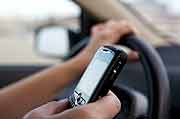- Double Mastectomy May Offer No Survival Benefit to Women With Breast Cancer
- Toxic Lead Found in Cinnamon Product, FDA Says
- Certain Abbott Blood Sugar Monitors May Give Incorrect Readings
- Athletes Can Expect High Ozone, Pollen Counts for Paris Olympics
- Fake Oxycontin Pills Widespread and Potentially Deadly: Report
- Shingles Vaccine Could Lower Dementia Risk
- Your Odds for Accidental Gun Death Rise Greatly in Certain States
- Kids From Poorer Families Less Likely to Survive Cancer
- Tough Workouts Won’t Trigger Cardiac Arrest in Folks With Long QT Syndrome
- At-Home Colon Cancer Test Can Save Lives
Distracted-Driving Deaths of Pedestrians, Cyclists Up in U.S., Study Finds


American pedestrians and bicyclists are being killed by distracted drivers in increasing numbers, a new study finds.
Pedestrian deaths caused by distracted driving — perhaps talking on cell phones, using a GPS or eating at the wheel — jumped nearly 50 percent in a recent five-year period, reaching 500 in 2010.
The number of bicyclists killed by distracted drivers increased 30 percent, from 56 in 2005 to 73 in 2010, according to the study, which was published in the November-December issue of the journal Public Health Reports.
“We’re constantly exposed to distracted drivers,” study author Fernando Wilson, an associate professor at the University of Nebraska Medical Center, said in a university news release.
“I don’t think there’s a day that I don’t see someone driving and using their cell phone. A lot of times they’re texting,” he said. “It’s something that’s pervasive in society. That’s one of the reasons it’s so difficult to deal with.”
White males ages 25 to 64 accounted for two-thirds of the pedestrian victims and 83 percent of the cyclist victims, according to the study. About half of the pedestrian and cyclist deaths occurred during daytime hours. Many were killed in cities and outside of marked crosswalks.
This disturbing trend runs counter to the overall decline in motor-vehicle deaths in the nation.
“People have to be aware that this problem is not going away anytime soon,” Wilson said. “When you’re crossing the street or cycling, you need to be cognizant about this new threat to roadway safety.”
A social stigma exists against drivers who don’t use seat belts or car seats for their young children, Wilson said. “If you don’t do these things, which now are the social norm, it’s viewed negatively. The laws are stricter,” he said. “With cell phones, we don’t have that social stigma. Not to mention that distracted driving is more difficult to enforce than other driving-safety laws.”
He said it’s likely that cases of distracted driving are underreported because it’s difficult for police to prove. This makes it difficult to implement effective policies to reduce the problem.
Data from the U.S. Fatality Analysis Reporting System was used for the study. Distracted driving was identified based on traffic-safety guidelines. This means police determined that a driver had been using a phone or other technological device, onboard navigation system, computer or two-way radio, or had been engaged in inattentive or careless activities.
More information
The U.S. National Highway Traffic Safety Administration has more about distracted driving.
Source: HealthDay
Copyright © 2024 HealthDay. All rights reserved.










